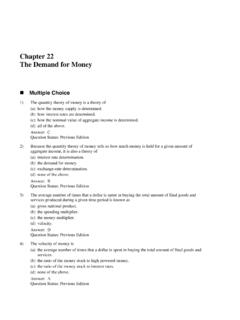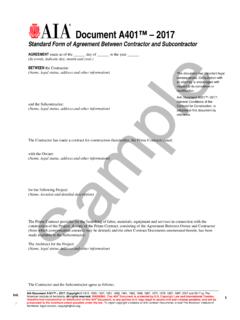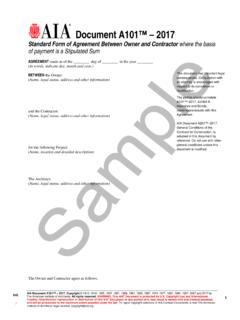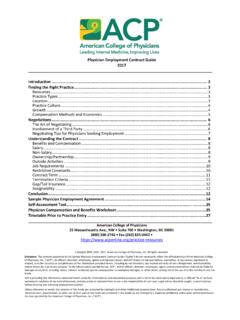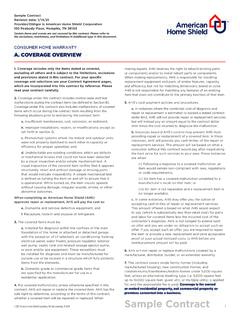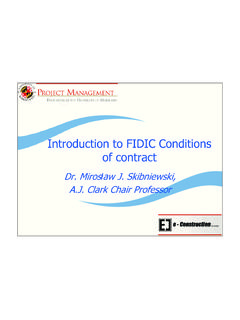Transcription of Chapter 13 Financial Derivatives
1 Chapter 13 Financial Derivatives Multiple Choice 1) The payoffs for Financial Derivatives are linked to (a) securities that will be issued in the future. (b) the volatility of interest rates. (c) previously issued securities. (d) government regulations specifying allowable rates of return. (e) none of the above. Answer: C Question Status: New 2) Financial Derivatives include (a) stocks. (b) bonds. (c) futures. (d) none of the above. Answer: C Question Status: Previous Edition 3) Financial Derivatives include (a) stocks. (b) bonds. (c) forward contracts. (d) both (a) and (b) are true. Answer: C Question Status: Previous Edition 4) Which of the following is not a Financial derivative? (a) Stock (b) Futures (c) Options (d) Forward contracts Answer: A Question Status: Previous Edition Chapter 13 Financial Derivatives 443 5) By hedging a portfolio, a bank manager (a) reduces interest rate risk.
2 (b) increases reinvestment risk. (c) increases exchange rate risk. (d) increases the probability of gains. Answer: A Question Status: Previous Edition 6) Which of the following is a reason to hedge a portfolio? (a) To increase the probability of gains. (b) To limit exposure to risk. (c) To profit from capital gains when interest rates fall. (d) All of the above. (e) Both (a) and (c) of the above. Answer: B Question Status: Revised 7) Hedging risk for a long position is accomplished by (a) taking another long position. (b) taking a short position. (c) taking additional long and short positions in equal amounts. (d) taking a neutral position. (e) none of the above. Answer: B Question Status: New 8) Hedging risk for a short position is accomplished by (a) taking a long position. (b) taking another short position. (c) taking additional long and short positions in equal amounts. (d) taking a neutral position. (e) none of the above.
3 Answer: A Question Status: New 9) A contract that requires the investor to buy securities on a future date is called a (a) short contract . (b) long contract . (c) hedge. (d) cross. Answer: B Question Status: Previous Edition 444 Frederic S. Mishkin Economics of Money, Banking, and Financial Markets, Seventh Edition 10) A long contract requires that the investor (a) sell securities in the future. (b) buy securities in the future. (c) hedge in the future. (d) close out his position in the future. Answer: B Question Status: Previous Edition 11) A person who agrees to buy an asset at a future date has gone (a) long. (b) short. (c) back. (d) ahead. (e) even. Answer: A Question Status: Study Guide 12) A short contract requires that the investor (a) sell securities in the future. (b) buy securities in the future. (c) hedge in the future. (d) close out his position in the future. Answer: A Question Status: Previous Edition 13) A contract that requires the investor to sell securities on a future date is called a (a) short contract .
4 (b) long contract . (c) hedge. (d) micro hedge. Answer: A Question Status: Previous Edition 14) If a bank manager chooses to hedge his portfolio of treasury securities by selling futures contracts, he (a) gives up the opportunity for gains. (b) removes the chance of loss. (c) increases the probability of a gain. (d) both (a) and (b) are true. Answer: D Question Status: Previous Edition Chapter 13 Financial Derivatives 445 15) To say that the forward market lacks liquidity means that (a) forward contracts usually result in losses. (b) forward contracts cannot be turned into cash. (c) it may be difficult to make the transaction. (d) forward contracts cannot be sold for cash. (e) none of the above. Answer: C Question Status: New 16) A disadvantage of a forward contract is that (a) it may be difficult to locate a counterparty. (b) the forward market suffers from lack of liquidity. (c) these contracts have default risk.
5 (d) all of the above. (e) both (a) and (c) of the above. Answer: D Question Status: New 17) Forward contracts are risky because they (a) are subject to lack of liquidity (b) are subject to default risk. (c) hedge a portfolio. (d) both (a) and (b) are true. Answer: D Question Status: Revised 18) The advantage of forward contracts over future contracts is that they (a) are standardized. (b) have lower default risk. (c) are more liquid. (d) none of the above. Answer: D Question Status: Previous Edition 19) The advantage of forward contracts over futures contracts is that they (a) are standardized. (b) have lower default risk. (c) are more flexible. (d) both (a) and (b) are true. Answer: C Question Status: Previous Edition 446 Frederic S. Mishkin Economics of Money, Banking, and Financial Markets, Seventh Edition 20) Forward contracts are of limited usefulness to Financial institutions because (a) of default risk.
6 (b) it is impossible to hedge risk. (c) of lack of liquidity. (d) all of the above. (e) both (a) and (c) of the above. Answer: E Question Status: New 21) Futures contracts are regularly traded on the (a) Chicago Board of Trade. (b) New York Stock Exchange. (c) American Stock Exchange. (d) Chicago Board of Options Exchange. Answer: A Question Status: Previous Edition 22) Hedging in the futures market (a) eliminates the opportunity for gains. (b) eliminates the opportunity for losses. (c) increases the earnings potential of the portfolio. (d) does all of the above. (e) does both (a) and (b) of the above. Answer: E Question Status: Study Guide 23) When interest rates fall, a bank that perfectly hedges its portfolio of Treasury securities in the futures market (a) suffers a loss. (b) experiences a gain. (c) has no change in its income. (d) none of the above. Answer: C Question Status: Study Guide 24) Futures markets have grown rapidly because futures (a) are standardized.
7 (b) have lower default risk. (c) are liquid. (d) all of the above. Answer: D Question Status: Previous Edition Chapter 13 Financial Derivatives 447 25) Parties who have bought a futures contract and thereby agreed to _____ (take delivery of) the bonds are said to have taken a ____ position. (a) sell; short (b) buy; short (c) sell; long (d) buy; long Answer: D Question Status: Previous Edition 26) Parties who have sold a futures contract and thereby agreed to _____ (deliver) the bonds are said to have taken a ____ position. (a) sell; short (b) buy; short (c) sell; long (d) buy; long Answer: A Question Status: Previous Edition 27) By selling short a futures contract of $100,000 at a price of 115 you are agreeing to deliver (a) $100,000 face value securities for $115,000. (b) $115,000 face value securities for $110,000. (c) $100,000 face value securities for $100,000. (d) $115,000 face value securities for $115,000.
8 Answer: A Question Status: Previous Edition 28) By selling short a futures contract of $100,000 at a price of 96 you are agreeing to deliver (a) $100,000 face value securities for $104,167. (b) $96,000 face value securities for $100,000. (c) $100,000 face value securities for $96,000. (d) $96,000 face value securities for $104,167. Answer: C Question Status: Revised 29) By buying a long $100,000 futures contract for 115 you agree to pay (a) $100,000 for $115,000 face value bonds. (b) $115,000 for $100,000 face value bonds. (c) $86,956 for $100,000 face value bonds. (d) $86,956 for $115,000 face value bonds. Answer: B Question Status: Previous Edition 448 Frederic S. Mishkin Economics of Money, Banking, and Financial Markets, Seventh Edition 30) On the expiration date of a futures contract , the price of the contract (a) always equals the purchase price of the contract . (b) always equals the average price over the life of the contract .
9 (c) always equals the price of the underlying asset. (d) always equals the average of the purchase price and the price of underlying asset. (e) cannot be determined. Answer: C Question Status: New 31) The price of a futures contract at the expiration date of the contract (a) equals the price of the underlying asset. (b) equals the price of the counterparty. (c) equals the hedge position. (d) equals the value of the hedged asset. (e) none of the above. Answer: A Question Status: Study Guide 32) Elimination of riskless profit opportunities in the futures market is (a) hedging. (b) arbitrage. (c) speculation. (d) underwriting. (e) diversification. Answer: B Question Status: New 33) If you purchase a $100,000 interest-rate futures contract for 110, and the price of the Treasury securities on the expiration date is 106 (a) your profit is $4000. (b) your loss is $4000. (c) your profit is $6000. (d) your loss is $6000.
10 (e) your profit is $10,000. Answer: B Question Status: New 34) If you purchase a $100,000 interest-rate futures contract for 105, and the price of the Treasury securities on the expiration date is 108 (a) your profit is $3000. (b) your loss is $3000. (c) your profit is $8000. (d) your loss is $8000. (e) your profit is $5000. Answer: A Question Status: New Chapter 13 Financial Derivatives 449 35) If you sell a $100,000 interest-rate futures contract for 110, and the price of the Treasury securities on the expiration date is 106 (a) your profit is $4000. (b) your loss is $4000. (c) your profit is $6000. (d) your loss is $6000. (e) your profit is $10,000. Answer: A Question Status: New 36) If you sell a $100,000 interest-rate futures contract for 105, and the price of the Treasury securities on the expiration date is 108 (a) your profit is $3000. (b) your loss is $3000. (c) your profit is $8000. (d) your loss is $8000.

